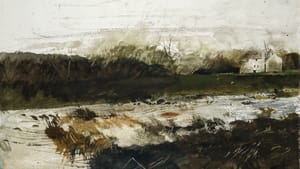Stay in the Loop
BSR publishes on a weekly schedule, with an email newsletter every Wednesday and Thursday morning. There’s no paywall, and subscribing is always free.
Andrew in the abstract
Brandywine Museum of Art presents Andrew Wyeth: Abstract Flash

With Abstract Flash, the Brandywine Museum of Art continues to reveal another layer of Andrew Wyeth’s artistic practice. This exhibition explores the museum’s contention that the Brandywine artist consistently used—and was deeply committed to—abstraction. Rather than eschewing the prevailing non-representational trend of his times, Wyeth surprisingly espoused it, and he adopted it as a working tool in his formidable artistic arsenal.
In this beautifully configured grouping, curators Karen Baumgartner and William Coleman show clearly that many of Wyeth’s finished “representational” works are deeply based on (and filled with) abstractions, which Wyeth employed freely, even when creating his intricate temperas. The exhibition’s title is taken from the artist’s words: “My struggle is to preserve that abstract flash, like something you caught out of the corner of your eye.” Wyeth’s definition of “abstract” is not conceptual: he often called himself an abstract artist, and when we look through the “corner” of his eye, anything but casual, we enter a deeply perceived reality.
Intimacy and power
These 37 never-before-seen watercolors range over six decades of Wyeth’s career, from 1946 (when he was an emerging presence) to 1996. They tellingly navigate the slippery terrain between America’s rising cult of mid-20th-century Abstract Expressionism and the recognizable images that preceded it. Since Wyeth made these as studies for larger pieces or explorations of something specific, only two are identified with a name: Ice Pool Study (1956) and Blue Ice Study (1996). Most of the watercolors have the universal appellation Untitled, and it’s only by their dates—carefully recorded by the artist’s wife, Betsy—that they can be catalogued and distinguished.
On view in a newly created gallery, each watercolor is framed in white and hung on a white wall, an elegantly realized installation that accents their intimacy while at the same time punching up their power. One of the earliest, Untitled 1948, was created the same year as the iconic Christina’s World, illustrating how Wyeth straddled two ways of working. Though clearly identifiable as branches over water, the work’s strong black lines nod to abstract expressionist Franz Kline. And another evocation of (possibly) the same scene, Untitled n.d. (the only undated work on view), was likely created 50 years later, proving that the artist’s abstract practice was lifelong.

Wyeth’s definition of abstraction included manipulating perspective to capture a mood, and he utilized these studies as a sort of diary, often starting with something recognizable and then deepening it into pure form and geometry. This is seen clearly in the smudged hills of Untitled 1961, a work in which both representational specificity and abstraction are equally present and equally compelling.
Defying classification
In Untitled 1982, a path through a landscape, you can clearly see the artist’s process and visual vocabulary, including his thumbprints incorporated into the work. And Untitled 1960 is exceptionally arresting: so clearly a portion of a tree and yet so perfect in its abstraction. These are technically “studies,” but they break the hierarchy of classification and stand as full compositions.
Though the individual works often have a surging internal energy, the exhibition itself radiates calm mastery, due in part to the natural-world subject matter but also reflecting the focus and assured, embracing eye of Baumgartner. She has worked closely with the Wyeth family for 20 years and is now part of the newly created Wyeth Study Center, located jointly at the Brandywine and the Farnsworth Art Museum in Rockland, Maine.
Now part of the Brandywine Museum of Art, the study center came to fruition in 2022 as an offshoot of the Wyeth Foundation for American Art’s Andrew and Betsy Wyeth Collection. The center, managed by the Brandywine’s William Coleman (who mounted the recently closed Home Places, the first of the center’s exhibitions), was formed to house the 7,000-plus unseen Wyeth works from which Abstract Flash was drawn.
Up next in the Wyeth world
This exhibition of Wyeth’s Pennsylvania work will be followed by one at the Farnsworth in the summer of 2024, which will feature works he created in Maine. Plans also include a deep dive into Betsy James Wyeth’s own substantial creative legacy and the huge task of publishing a catalogue raisonné, a comprehensive annotated listing of all known Wyeth works.
Among the ephemera on view is fascinating correspondence from American realist Edward Hopper requesting that Wyeth help him oppose the Whitney Museum’s leaning toward “non-objective art” and the Wyeths’ diplomatic response declining to participate. This fall, the Brandywine will publish an exhibition catalogue with essays by both Coleman and Baumgartner, who notes that “these are some of the most spontaneous and free works that Andrew Wyeth ever produced ... showing [him] thinking, and feeling, on paper.”
What, When, Where
Abstract Flash: Unseen Andrew Wyeth. Through February 18, 2024, at the Brandywine Museum of Art, 1 Hoffman’s Mill Road, Chadds Ford. $6-$18 (free for members and children under 6). (610) 388-2700 or brandywine.org.
Accessibility
The entire museum (including the Millstone Café) is wheelchair-accessible, with accessible parking, barrier-free entrance, and available wheelchairs. Service animals are welcome.
Masks are not required.
Sign up for our newsletter
All of the week's new articles, all in one place. Sign up for the free weekly BSR newsletters, and don't miss a conversation.

 Gail Obenreder
Gail Obenreder